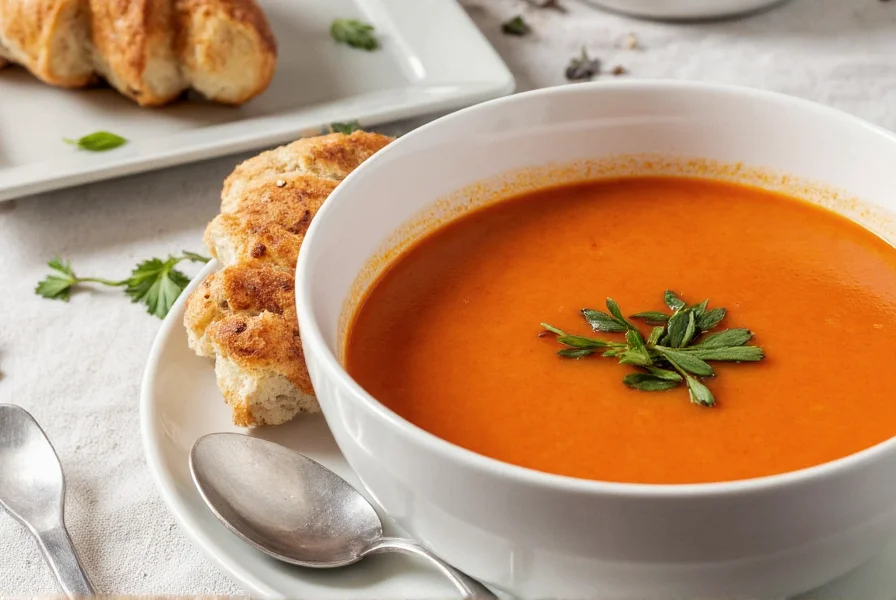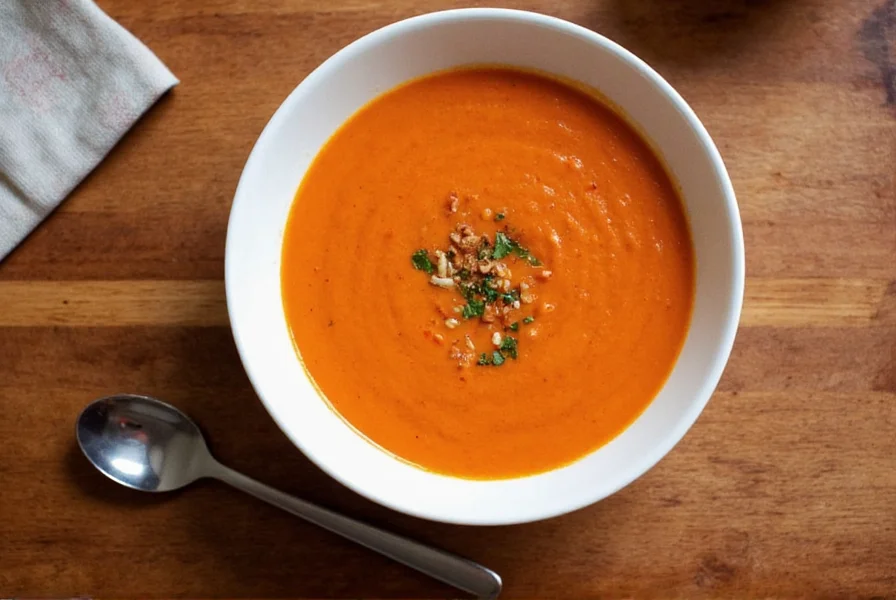Here's a straightforward roasted red pepper soup recipe that yields a velvety, flavorful soup in under 45 minutes: Roast 4 large red bell peppers and 1 onion at 400°F for 30 minutes. Sauté 3 garlic cloves, add roasted vegetables, 4 cups vegetable broth, and simmer 15 minutes. Blend until smooth, then stir in 1/2 cup heavy cream (optional) and season with salt, pepper, and smoked paprika. Serves 4–6.
Nothing beats the vibrant flavor of homemade roasted red pepper soup, especially when you control the ingredients and avoid preservatives found in store-bought versions. This recipe delivers restaurant-quality results with pantry staples and delivers that signature sweet-smoky depth only achieved through proper roasting. Whether you're meal prepping for the week or creating an elegant starter for guests, this versatile soup adapts beautifully to dietary preferences while maintaining its rich character.
The Secret to Exceptional Roasted Red Pepper Soup
While many recipes simply call for “roasted red peppers,” the technique matters significantly. Proper roasting transforms bell peppers' natural sugars through caramelization, creating complex flavor notes that canned alternatives can't match. The key is achieving blistered, blackened skin without burning the flesh – this develops that essential smoky-sweet profile that defines exceptional roasted red pepper soup.
Essential Ingredients and Why They Matter
Quality ingredients make the difference between ordinary and extraordinary soup. Here's what you'll need and why each component contributes to the final result:
| Ingredient | Quantity | Why It Matters |
|---|---|---|
| Red bell peppers | 4 large | Choose firm, deep red peppers for maximum sweetness and color |
| Yellow onion | 1 medium | Yellow onions provide better caramelization than white varieties |
| Garlic cloves | 3–4 | Roasting whole cloves prevents bitterness while adding depth |
| Olive oil | 2 tbsp | Extra virgin for flavor, not just cooking fat |
| Vegetable broth | 4 cups | Low-sodium allows proper seasoning control |
| Heavy cream | 1/2 cup (optional) | Adds luxurious texture; omit for dairy-free version |
| Smoked paprika | 1 tsp | Enhances roasted notes without overpowering |
Step-by-Step Preparation Guide
Roasting the Vegetables
Preheat your oven to 400°F (200°C). Place whole red peppers and onion (unpeeled) on a baking sheet lined with parchment paper. Drizzle with 1 tablespoon olive oil and rub to coat. Roast for 30–35 minutes, turning halfway, until skins are blackened and blistered. Transfer to a bowl and cover with plastic wrap for 10 minutes – this steaming process loosens the skins.
Preparing the Soup Base
While vegetables roast, heat remaining olive oil in a large pot over medium heat. Add unpeeled garlic cloves and sauté for 2 minutes until fragrant but not browned. Remove blackened skins from peppers and onion, then roughly chop and add to the pot along with any accumulated juices.
Simmering and Blending
Pour in vegetable broth, bring to a gentle simmer, and cook for 15 minutes to allow flavors to meld. Remove garlic cloves, then use an immersion blender to puree until completely smooth (or carefully transfer to a countertop blender in batches). Return to low heat.
Finishing Touches
Stir in heavy cream if using, then season with 1 teaspoon smoked paprika, 1/2 teaspoon salt, and freshly ground black pepper to taste. For optimal flavor development, let the soup rest off heat for 10 minutes before serving – this allows the flavors to harmonize.

Pro Tips for Perfect Roasted Red Pepper Soup Every Time
Professional chefs know these subtle techniques make significant differences in your creamy roasted red pepper soup from scratch:
- Skin removal matters: Don't rinse roasted peppers under water – this washes away flavorful juices. Instead, gently rub skins off with your fingers over the bowl to capture all those delicious roasting liquids
- Temperature control: Never boil the soup after adding cream – maintain a gentle simmer below 180°F to prevent curdling
- Flavor layering: Add a Parmesan rind while simmering for umami depth (remove before blending)
- Texture refinement: For ultra-smooth restaurant texture, strain through a fine-mesh sieve after blending
Variations for Dietary Needs and Preferences
This healthy roasted red pepper soup recipe adapts beautifully to various dietary requirements without sacrificing flavor:
Dairy-Free Version
Replace heavy cream with 1/2 cup full-fat coconut milk or 1/4 cup raw cashews blended with 1/2 cup broth. The cashew version provides similar creaminess without coconut flavor.
Spicy Roasted Red Pepper Soup
Add 1/2 teaspoon red pepper flakes when sautéing garlic, or stir in 1 minced chipotle pepper in adobo sauce after blending for smoky heat.
Roasted Red Pepper and Tomato Fusion
Add 1 cup roasted tomatoes (canned or fresh) for a deeper, more complex flavor profile that works beautifully with grilled cheese sandwiches.

Serving Suggestions and Pairings
Elevate your roasted red pepper soup recipe with roasted garlic with these professional pairing recommendations:
- Classic pairing: Crusty baguette with olive oil and balsamic dip
- Elegant presentation: Swirl of pesto or basil oil and microgreens
- Complete meal: Grilled cheese sandwich using sharp cheddar and gruyere
- Protein boost: Top with white beans or shredded rotisserie chicken
Storage and Reheating Instructions
This easy roasted red pepper soup recipe stores exceptionally well, making it perfect for meal prep:
- Refrigeration: Store in airtight container for up to 5 days
- Freezing: Freeze without cream for up to 3 months (add cream when reheating)
- Reheating: Warm gently over medium-low heat, stirring frequently. If soup has thickened, add small amounts of broth or water to reach desired consistency
Why This Recipe Stands Out From Others
Many quick roasted red pepper soup for busy weeknights recipes cut corners that compromise flavor. This version maintains integrity through proper roasting technique, balanced seasoning, and attention to texture. The 30-minute roasting time isn't optional – it's what transforms simple ingredients into something extraordinary. Unlike recipes that rely on canned peppers or excessive cream, this approach delivers vibrant color and clean flavor that showcases the natural sweetness of perfectly roasted peppers.
Frequently Asked Questions
Can I use jarred roasted red peppers instead of roasting fresh ones?
While jarred peppers work in a pinch, they lack the depth of freshly roasted peppers. If using jarred, select oil-packed varieties without vinegar, drain well, and pat dry before adding to maintain proper soup consistency. Expect less vibrant flavor and color compared to fresh-roasted peppers.
How can I make this soup thicker without adding more cream?
For a naturally thicker texture, simmer uncovered for 5-10 minutes to reduce liquid. Alternatively, blend in 1/4 cup cooked white beans or 2 tablespoons raw oats before pureeing. Both options add creaminess while boosting nutritional value without dairy.
What's the best way to store leftovers of roasted red pepper soup?
Cool soup completely before transferring to airtight containers. Store in the refrigerator for up to 5 days. For longer storage, freeze in portion-sized containers for up to 3 months (omit cream before freezing). When reheating frozen soup, add cream after thawing and warming.
Can this roasted red pepper soup be made in an Instant Pot?
Yes! Use the sauté function to cook garlic, then add roasted peppers, broth, and seasonings. Pressure cook on high for 5 minutes, then quick release. Blend as directed. Note that roasting peppers still requires oven time, but the simmering step is significantly reduced.











 浙公网安备
33010002000092号
浙公网安备
33010002000092号 浙B2-20120091-4
浙B2-20120091-4